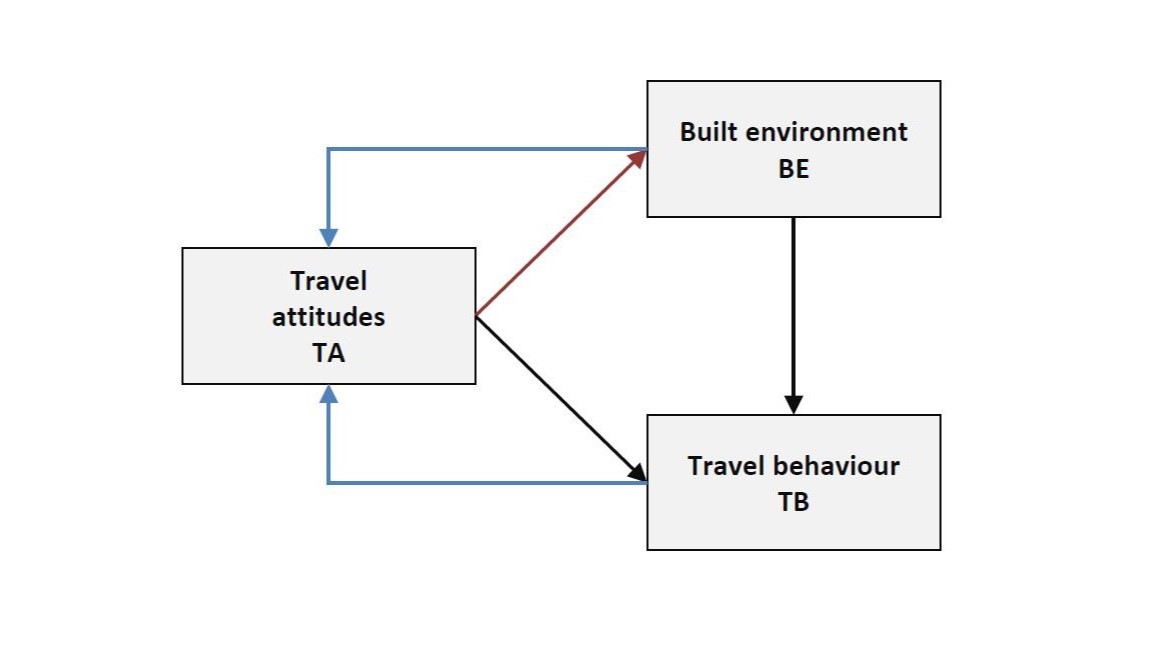Residential self-selection
Student information
Author: Govert van Loon
Institution: Delft University of Technology
Graduation year: 2023
Residential self-selection, travel behaviour and attitudes
With the transition to more sustainable transport systems, many different concepts and innovations have arisen. One of these is the car-free neighbourhood, which discourages car use through an urban design that favours active modes of transport, and leaves less space for private cars.
Developers aim to create urban and rural environments that encourage sustainable transport, in line with the wider objectives of reducing transport emissions and improving urban liveability. Achieving this transition requires a nuanced understanding of the complex urban planning relationships between the built environment (BE), travel attitudes (TA) and travel behaviour (TB).
Research in this area has consistently shown that the built environment has a significant impact on travel behaviour. The consensus is that mixed-use neighbourhoods equipped with sustainable transport options encourage residents to travel less by car and more by public transport or active modes of transport such as walking and cycling.
However, the impact of the built environment on travel behaviour is intertwined with individuals' travel attitudes (TA). This relationship introduces the concept of residential self-selection (RSS), where people not only adapt to their environment but also select an environment which is consistent with their travel preferences and attitudes.
This study focuses on the relationship between the built environment (BE), travel behaviour (TB), and travel attitudes (TA) of people who move home. Using data from the Netherlands Mobility Panel(MPN), the study uses a basic cross-lagged panel model (CLPM) and a random intercept cross-lagged panel model (RI-CLPM) to identify the causal relationships between BE, TA, and TB and public and private transport before and after moving home.

Relationship between TA, TB and BE
The three-day travel diary extracted from the MPN data was used to specify travel behaviour through a variable derived from the total car kilometres driven. Questions on mode of transport preference for different travel purposes were used to identify travel attitudes. The built environment was defined by an urbanisation indicator provided by Statistics Netherlands. The data sample was created from MPN respondents with complete data points in three consecutive waves between 2014 and 2019, and who had moved home between their first and second data wave. This resulted in a data sample consisting of 347 respondents.
Both models showed that residential self-selection (RSS) is a significant factor. It suggests that people tend to move to environments that match their pre-existing travel attitudes. The RI-CLPM introduces a reverse causality effect, suggesting that the built environment after moving can influence travel attitudes one year later. However, there is also a reciprocal effect from travel attitudes after moving to the built environment.
Surprisingly, the RI-CLPM does not identify any effects on changes in travel behaviour, such as changes in car kilometres driven, that can be attributed to the built environment or travel attitudes. On the other hand, the CLPM does find relationships between travel attitudes and behaviour, suggesting these are influenced by stable, time-invariant third variables that the RI-CLPM most likely factors out.
Despite its valuable findings, the study acknowledges limitations related to the operationalisation of variables and the sample size. Further research into more reliable specifications of travel behaviour, exploring different types of relocation, and considering the influence of time-varying third variables is recommended.
In particular, the study highlights the theoretical advantage of the RI-CLPM and recommends its use in future research. It emphasises that conclusions drawn from CLPM studies may lead to erroneous conclusions about causal mechanisms.
Policy implications are highlighted in the context of limited evidence to explain changes in travel behaviour. The study suggests that facilitating opportunities for people with a lower preference for travel by car to relocate to dense neighbourhoods with reliable alternative transport options, may encourage more sustainable travel behaviour. However, the need for more robust evidence poses a challenge in translating these findings into concrete policy recommendations.
The lack of evidence to explain changes in travel behaviour makes it difficult to translate the findings into policy recommendations. One recommendation is to encourage people with a lower car preference to relocate to densely populated neighbourhoods with reliable alternatives, so they can self-select and practice more sustainable travel behaviour.
If future research confirms that changes in travel attitudes after relocating do lead to changes in behaviour, policymakers should target recent movers to dense areas, and inform them about sustainable travel options. This approach aims to reduce car preference by encouraging residents to seek and adopt alternative modes and change their travel behaviour.
